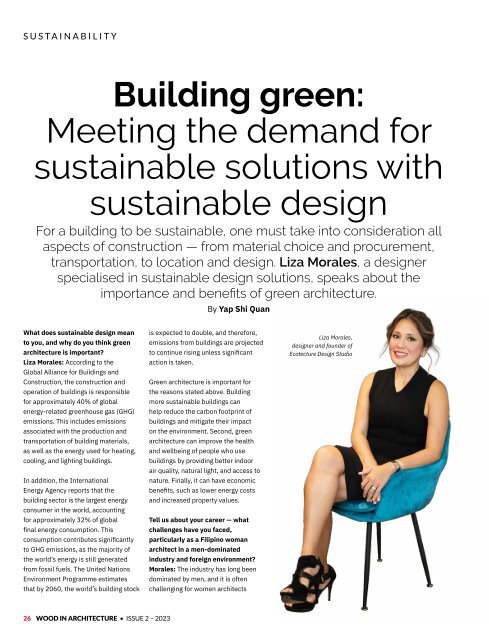WIA_ISSUE2_2023
Create successful ePaper yourself
Turn your PDF publications into a flip-book with our unique Google optimized e-Paper software.
SUSTAINABILITY<br />
Building green:<br />
Meeting the demand for<br />
sustainable solutions with<br />
sustainable design<br />
For a building to be sustainable, one must take into consideration all<br />
aspects of construction — from material choice and procurement,<br />
transportation, to location and design. Liza Morales, a designer<br />
specialised in sustainable design solutions, speaks about the<br />
importance and benefits of green architecture.<br />
By Yap Shi Quan<br />
What does sustainable design mean<br />
to you, and why do you think green<br />
architecture is important?<br />
Liza Morales: According to the<br />
Global Alliance for Buildings and<br />
Construction, the construction and<br />
operation of buildings is responsible<br />
for approximately 40% of global<br />
energy-related greenhouse gas (GHG)<br />
emissions. This includes emissions<br />
associated with the production and<br />
transportation of building materials,<br />
as well as the energy used for heating,<br />
cooling, and lighting buildings.<br />
In addition, the International<br />
Energy Agency reports that the<br />
building sector is the largest energy<br />
consumer in the world, accounting<br />
for approximately 32% of global<br />
final energy consumption. This<br />
consumption contributes significantly<br />
to GHG emissions, as the majority of<br />
the world’s energy is still generated<br />
from fossil fuels. The United Nations<br />
Environment Programme estimates<br />
that by 2060, the world’s building stock<br />
is expected to double, and therefore,<br />
emissions from buildings are projected<br />
to continue rising unless significant<br />
action is taken.<br />
Green architecture is important for<br />
the reasons stated above. Building<br />
more sustainable buildings can<br />
help reduce the carbon footprint of<br />
buildings and mitigate their impact<br />
on the environment. Second, green<br />
architecture can improve the health<br />
and wellbeing of people who use<br />
buildings by providing better indoor<br />
air quality, natural light, and access to<br />
nature. Finally, it can have economic<br />
benefits, such as lower energy costs<br />
and increased property values.<br />
Tell us about your career — what<br />
challenges have you faced,<br />
particularly as a Filipino woman<br />
architect in a men-dominated<br />
industry and foreign environment?<br />
Morales: The industry has long been<br />
dominated by men, and it is often<br />
challenging for women architects<br />
Liza Morales,<br />
designer and founder of<br />
Ecotecture Design Studio<br />
26 WOOD IN ARCHITECTURE • ISSUE 2 – <strong>2023</strong>

















